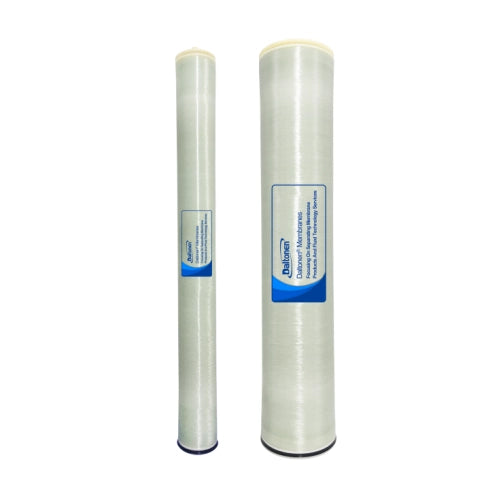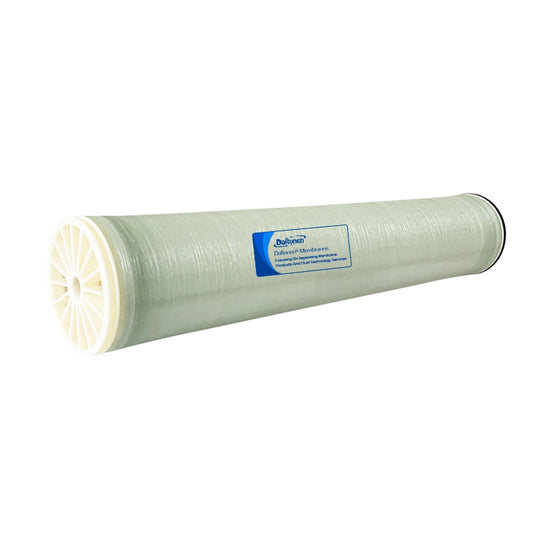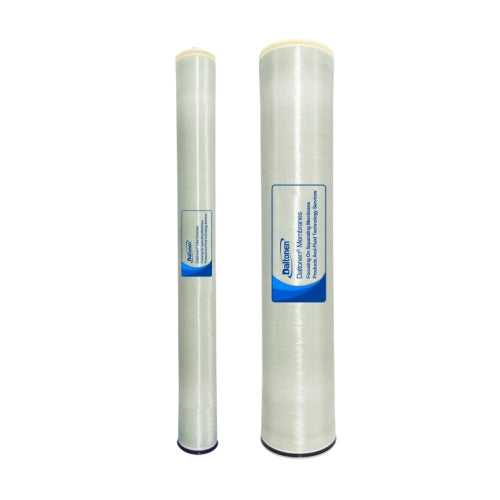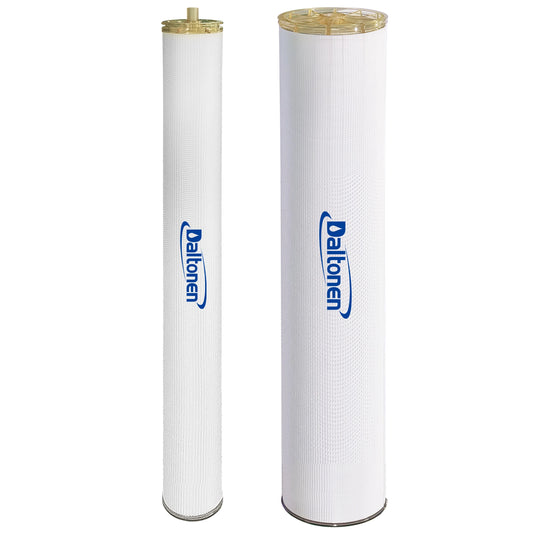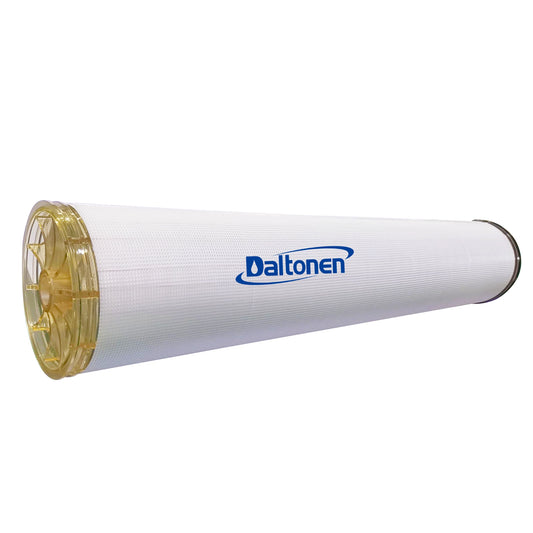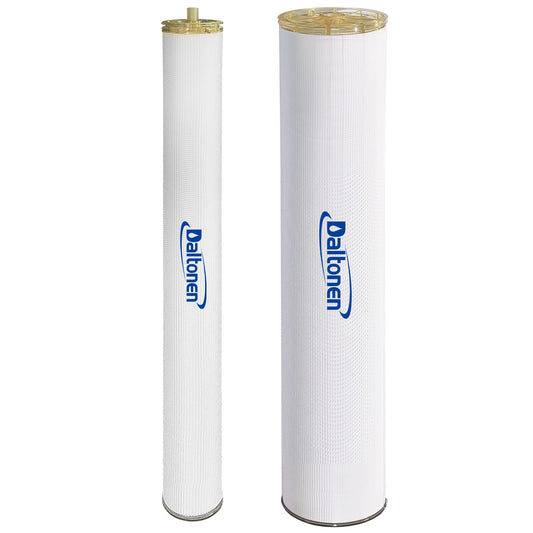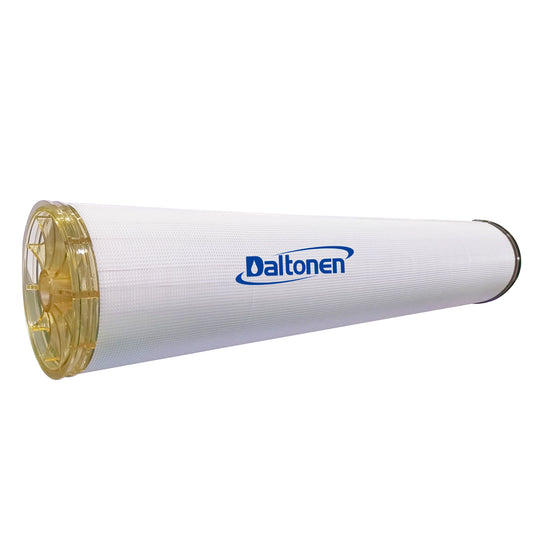In Which Industry Fields Are Hollow Fiber Ultrafiltration Membranes Applied?
19 May 2025
1. Water Treatment Industry
1.1 Municipal Water Purification
Hollow fiber ultrafiltration membranes play a significant role in municipal water purification. These membranes can effectively remove suspended solids, colloids, bacteria, viruses, and other impurities from water, with a filtration accuracy typically ranging from 0.01 to 0.1 micrometers. According to relevant research, municipal water treated with hollow fiber ultrafiltration membranes can reduce turbidity to below 0.1 NTU, achieve a bacterial removal rate of over 99.99%, and a virus removal rate of more than 99.9%, significantly enhancing water quality safety to meet the high standards required for daily residential use.
In some large municipal water plants, ultrafiltration membrane systems have gradually replaced traditional sand filtration processes. For instance, a water plant with a daily treatment capacity of 100,000 tons adopted hollow fiber ultrafiltration membrane technology, which not only improved water quality but also reduced operating costs. Compared to traditional processes, the ultrafiltration membrane system reduced the plant's footprint by about 30% and decreased the use of chemical agents, lowering operating and maintenance costs by approximately 20%. Additionally, the high degree of automation of ultrafiltration membranes allows for online cleaning and monitoring, further enhancing the plant's operational efficiency and stability.

1.2 Advanced Wastewater Treatment and Reuse
Hollow fiber ultrafiltration membranes have significant advantages in the field of advanced wastewater treatment and reuse. With the intensification of water resource shortages, wastewater reuse has become an important solution to urban water problems. Ultrafiltration membranes can deeply purify wastewater, removing most pollutants and enabling the effluent to meet reuse standards. In practical applications, ultrafiltration membranes are often used in conjunction with other technologies such as reverse osmosis to further improve the quality and efficiency of wastewater reuse.
For example, in a wastewater treatment plant in an industrial park, a "ultrafiltration + reverse osmosis" dual-membrane process was used to treat textile wastewater. After pre-treatment with ultrafiltration membranes, suspended solids and large molecular organic substances in the water were effectively removed, significantly reducing the pollution load on the subsequent reverse osmosis membranes. The final effluent quality met industrial water reuse standards, with a reuse rate of over 70%. This not only alleviated the water pressure in the park but also reduced environmental pollution. Statistics show that the plant saves about 1 million tons of fresh water annually and reduces a large amount of wastewater discharge, achieving significant economic and environmental benefits.
1.3 Seawater Desalination Pretreatment
In the field of seawater desalination, hollow fiber ultrafiltration membranes are an essential pretreatment technology. Seawater contains a large amount of salts, microorganisms, suspended solids, and other impurities. Direct desalination treatment would lead to pollution and blockage of subsequent equipment such as reverse osmosis membranes. Ultrafiltration membranes can effectively remove suspended solids, colloids, and microorganisms from seawater, reducing turbidity and SDI (pollution index) to provide high-quality feed water for the subsequent reverse osmosis desalination process.
For example, in a seawater desalination plant in a coastal city, hollow fiber ultrafiltration membranes were used as the pretreatment system. After treatment with ultrafiltration membranes, the SDI value of seawater was reduced from above 10 to below 3, and turbidity was lowered to below 0.2 NTU. This significantly extended the service life of reverse osmosis membranes, reduced cleaning frequency, and the use of chemical agents. Compared to desalination plants without ultrafiltration pretreatment, the replacement cycle of reverse osmosis membranes in this plant was extended by about 50%, and operating costs were reduced by about 30%. Meanwhile, the efficient pretreatment capability of ultrafiltration membranes ensured the stable operation of the seawater desalination system, improving the efficiency and reliability of seawater desalination and providing strong support for solving the freshwater shortage in coastal areas.
2. Food and Beverage Industry
2.1 Juice Concentration and Clarification
Hollow fiber ultrafiltration membranes have significant application value in the field of juice concentration and clarification. Ultrafiltration membranes can effectively remove suspended solids, pectin, microorganisms, and other impurities from juice while retaining the nutritional components and flavor substances in the juice. The filtration accuracy is generally between 0.1 and 0.2 micrometers, enabling efficient clarification and concentration of juice.
In practical applications, ultrafiltration membrane technology can reduce the turbidity of juice to below 0.1 NTU and decrease the total bacterial count by over 99.9%, significantly improving the quality and safety of the juice. For example, a large juice manufacturing company used hollow fiber ultrafiltration membrane technology to treat apple juice. The treated apple juice had high clarity, a pure taste, and minimal loss of nutritional components. Compared to traditional clarification processes, the shelf life of juice treated with ultrafiltration membrane technology was extended by about 30%, and the use of chemical additives was reduced, meeting modern consumers' demand for healthy beverages.
Moreover, ultrafiltration membrane technology can also achieve low-temperature concentration of juice, avoiding the destruction of juice quality caused by high-temperature treatment. During the concentration process, ultrafiltration membranes can effectively separate water and soluble solids in the juice, with a concentration factor of 3 to 5 times, greatly improving the efficiency of juice storage and transportation. Statistics show that using ultrafiltration membrane technology to concentrate juice reduces energy consumption by about 40% compared to traditional evaporation concentration processes, offering significant economic and environmental benefits.
2.2 Beer and Other Alcoholic Beverage Refining
Hollow fiber ultrafiltration membranes play an important role in the refining of beer and other alcoholic beverages. In beer production, ultrafiltration membranes can be used to remove yeast, suspended solids, and microorganisms from beer, improving the clarity and stability of the beer. The filtration accuracy is usually between 0.05 and 0.1 micrometers, effectively removing tiny particles and microorganisms in beer to ensure its taste and quality.
For example, a brewery used hollow fiber ultrafiltration membrane technology to refine beer. The treated beer had turbidity reduced to below 0.05 EBC, microbial content met national health standards, and the shelf life of the beer was extended by about 20%. Ultrafiltration membrane technology can also achieve sterile filtration of beer, avoiding the destruction of beer flavor caused by traditional heat sterilization processes and retaining the original flavor and taste of beer.
In the refining of other alcoholic beverages, such as wine and spirits, ultrafiltration membrane technology also has wide applications. Ultrafiltration membranes can remove impurities and suspended solids from alcoholic beverages, improving their clarity and transparency while retaining the aroma and flavor substances in the beverages. In wine production, ultrafiltration membranes can be used to remove pigments, proteins, and other impurities from wine to improve wine quality and stability. In spirits production, ultrafiltration membranes can be used to remove impurities and off-flavors from spirits to improve their taste and quality.
2.3 Tea Beverage Purification and Concentration
Hollow fiber ultrafiltration membranes have significant application value in the purification and concentration of tea beverages. Tea beverages contain a large amount of nutritional components such as tea polyphenols and catechins, but also some impurities and microorganisms. Ultrafiltration membranes can effectively remove suspended solids, microorganisms, and large molecular impurities from tea beverages while retaining the nutritional components and flavor substances in the beverages.
In practical applications, ultrafiltration membrane technology can reduce the turbidity of tea beverages to below 0.05 NTU and decrease the total bacterial count by over 99.9%, significantly improving the quality and safety of the tea beverages. For example, a tea beverage manufacturing company used hollow fiber ultrafiltration membrane technology to treat green tea beverages. The treated green tea beverages had high clarity, a pure taste, and minimal loss of nutritional components. Compared to traditional purification processes, the shelf life of tea beverages treated with ultrafiltration membrane technology was extended by about 25%, and the use of chemical additives was reduced, meeting modern consumers' demand for healthy beverages.
Moreover, ultrafiltration membrane technology can also achieve low-temperature concentration of tea beverages, avoiding the destruction of tea beverage quality caused by high-temperature treatment. During the concentration process, ultrafiltration membranes can effectively separate water and soluble solids in tea beverages, with a concentration factor of 2 to 3 times, greatly improving the efficiency of tea beverage storage and transportation. Statistics show that using ultrafiltration membrane technology to concentrate tea beverages reduces energy consumption by about 35% compared to traditional evaporation concentration processes, offering significant economic and environmental benefits.
3. Biomedical Industry
3.1 Preparation of Traditional Chinese Medicine Preparations
Hollow fiber ultrafiltration membranes have unique advantages in the preparation of traditional Chinese medicine (TCM) preparations, effectively enhancing the quality and safety of TCM products.
-
Impurity Removal and Active Ingredient Retention: TCM extracts contain a large number of impurities such as proteins, polysaccharides, and tannins, which can affect the stability and efficacy of TCM preparations. Hollow fiber ultrafiltration membranes can effectively remove these impurities while retaining the active ingredients in TCM. For example, in the treatment of a certain TCM extract, ultrafiltration membranes can reduce protein content by over 90%, while the loss rate of active ingredients is only about 5%, significantly improving the purity and quality of TCM preparations.
-
Enhanced Preparation Stability: TCM extracts treated with ultrafiltration membranes exhibit higher stability, reducing sedimentation and turbidity. In practical applications, a TCM oral liquid treated with ultrafiltration membrane technology had its stability significantly improved, with a shelf life extended by about 30%, and better taste and appearance.
-
Reduced Production Costs: The use of ultrafiltration membrane technology simplifies the complexity of traditional processes such as precipitation and filtration, reducing energy consumption and the use of chemical reagents in the production process. Statistics show that the production cost of TCM preparations using ultrafiltration membrane technology was reduced by about 20%, while production efficiency was increased.
3.2 Separation and Refining of Blood Products
Hollow fiber ultrafiltration membranes play an important role in the separation and refining of blood products, effectively improving the purity and safety of these products.
-
Efficient Separation and Purification: Ultrafiltration membranes can effectively separate different components in blood, such as plasma proteins and immunoglobulins. With high filtration accuracy, they can achieve efficient purification of blood products. For example, in the refining process of immunoglobulins, ultrafiltration membranes can reduce impurity content to below 0.1%, increasing purity to over 98%, significantly improving the quality of blood products.
-
Virus and Microorganism Removal: The safety of blood products is crucial, and ultrafiltration membranes can effectively remove viruses and microorganisms from blood. Studies have shown that ultrafiltration membranes can achieve a virus removal rate of over 99.99% and a bacterial removal rate close to 100%, ensuring the safety of blood products.
-
Reduced Risk of Immune Reactions: Blood products treated with ultrafiltration membranes have low impurity content, which can reduce the risk of immune reactions in patients during use. In clinical applications, the incidence of adverse reactions in patients using blood products treated with ultrafiltration membranes was reduced by about 50%, improving the safety and reliability of blood products.
3.3 Sterilization of Medical Water
Hollow fiber ultrafiltration membranes have significant application value in the sterilization of medical water, providing high-quality water sources for medical equipment and surgeries.
-
High-Efficiency Sterilization Capability: Ultrafiltration membranes can effectively remove bacteria, viruses, fungi, and other microorganisms from medical water. With a filtration accuracy generally between 0.01 and 0.1 micrometers, they can increase the bacterial removal rate to over 99.99% and the virus removal rate to over 99.9%, ensuring the sterility of medical water.
-
Endotoxin Removal: In addition to removing microorganisms, ultrafiltration membranes can also effectively remove endotoxins from medical water. Studies have shown that ultrafiltration membranes can reduce endotoxin content to below 0.01 EU/ml, meeting the strict standards for medical water and reducing the potential harm of endotoxins to patients' health.
-
Reduced Maintenance Costs: Compared to traditional sterilization processes, ultrafiltration membrane systems have a high degree of automation, stable operation, and low maintenance costs. Their online cleaning and monitoring functions can effectively extend the service life of the membranes, reducing replacement frequency. Statistics show that medical water systems using ultrafiltration membrane technology have maintenance costs reduced by about 30%, while improving the system's operational efficiency and reliability.

4. Industrial Production Field
4.1 Petrochemical Wastewater Treatment
Hollow fiber ultrafiltration membranes play a significant role in the treatment of petrochemical wastewater, effectively removing suspended solids, oils, colloids, and other impurities from the wastewater, enhancing its biodegradability, and creating favorable conditions for subsequent treatment processes.
-
Significant Removal Effect: Petrochemical wastewater contains a large amount of suspended solids and oily substances. The filtration accuracy of ultrafiltration membranes is generally between 0.01 and 0.1 micrometers, which can effectively remove suspended solids and oils from the wastewater. For example, in the wastewater treatment of a petrochemical enterprise, ultrafiltration membranes can increase the removal rate of suspended solids to over 95% and the removal rate of oils to over 80%, significantly improving the quality of the wastewater.
-
Reduced Treatment Costs: The application of ultrafiltration membrane technology reduces the use of chemical agents in traditional treatment processes, lowering treatment costs. Statistics show that using ultrafiltration membrane technology to treat petrochemical wastewater reduces the use of chemical agents by about 30% and operating costs by about 20%.
-
Improved Treatment Efficiency: Ultrafiltration membrane systems have a high degree of automation and stable operation, capable of online cleaning and monitoring, which enhances the efficiency and stability of wastewater treatment. Compared to traditional treatment processes, the treatment efficiency of ultrafiltration membrane systems is increased by about 30%, and the operating time is shortened by about 20%.
4.2 High-Purity Water Preparation in the Electronics Industry
In the electronics industry, high-purity water is an indispensable resource in the production process, and hollow fiber ultrafiltration membranes have significant application value in the preparation of high-purity water.
-
Efficient Removal of Impurities: The electronics industry has extremely high requirements for the quality of high-purity water. Ultrafiltration membranes can effectively remove suspended solids, microorganisms, organic substances, and other impurities from water, ensuring that the quality of high-purity water meets standards. For example, in the high-purity water preparation system of an electronics company, ultrafiltration membranes can reduce the content of suspended solids in water to below 0.1 mg/L and decrease the total bacterial count by over 99.99%, significantly improving the quality of high-purity water.
-
Improved Water Quality Stability: Ultrafiltration membrane systems can stably provide high-quality high-purity water, meeting the strict requirements of the electronics industry production process. With high filtration accuracy, they can effectively remove tiny particles and microorganisms from water, ensuring the stability of water quality. Statistics show that high-purity water prepared using ultrafiltration membrane technology has improved water quality stability by about 30%, reducing production problems caused by water quality fluctuations.
-
Reduced Energy Consumption and Costs: Ultrafiltration membrane technology has low energy consumption in the preparation of high-purity water and reduces the use of chemical agents, lowering production costs. Compared to traditional preparation processes, ultrafiltration membrane technology reduces energy consumption by about 25% and operating costs by about 15%.
4.3 Wastewater Treatment in Papermaking, Electroplating, and Chemical Industries
The wastewater from papermaking, electroplating, and chemical industries is complex in composition, containing a large number of heavy metal ions, organic substances, suspended solids, and other pollutants. Hollow fiber ultrafiltration membranes have significant application advantages in the treatment of these wastewaters.
-
Removal of Heavy Metal Ions: In electroplating wastewater, ultrafiltration membranes can effectively remove heavy metal ions such as copper, zinc, and nickel from the wastewater. Studies have shown that the removal rate of heavy metal ions by ultrafiltration membranes can reach over 80%, significantly reducing the pollution of wastewater to the environment.
-
Removal of Organic Substances and Suspended Solids: Papermaking and chemical wastewater contain a large amount of organic substances and suspended solids. Ultrafiltration membranes can effectively remove these pollutants, enhancing the biodegradability of the wastewater. For example, in the wastewater treatment of a papermaking enterprise, ultrafiltration membranes can increase the removal rate of organic substances to over 70% and the removal rate of suspended solids to over 90%, significantly improving the quality of the wastewater.
-
Reduced Treatment Difficulty and Costs: The application of ultrafiltration membrane technology reduces the use of chemical agents in the wastewater treatment process, lowering treatment difficulty and costs. Statistics show that using ultrafiltration membrane technology to treat wastewater from papermaking, electroplating, and chemical industries reduces the use of chemical agents by about 40% and operating costs by about 25%.
5. Other Fields
5.1 Household Water Purification Devices
Hollow fiber ultrafiltration membranes are widely used in household water purification devices, providing efficient and convenient water purification solutions for families.
-
High-Efficiency Water Purification: Ultrafiltration membranes can effectively remove suspended solids, bacteria, viruses, colloids, and other impurities from water, with a filtration accuracy typically ranging from 0.01 to 0.1 micrometers. For example, a brand of household water purifier using hollow fiber ultrafiltration membrane technology can increase the bacterial removal rate to over 99.99% and the virus removal rate to over 99.9%, significantly improving the safety of household water.
-
Retention of Beneficial Minerals: Compared to reverse osmosis membranes, ultrafiltration membranes can retain beneficial minerals such as calcium and magnesium in water while removing harmful impurities, meeting the demand for healthy drinking water in families.
-
Miniaturization and Intelligence: Ultrafiltration membrane components in household water purification devices are usually designed compactly for easy installation and use. At the same time, many modern household water purifiers are equipped with intelligent monitoring systems that can monitor water quality and membrane operation status in real-time, reminding users to replace filter cores in time to ensure the long-term stable operation of the devices.
-
Market Demand Growth: With increasing attention to drinking water quality, the market for household water purification devices is growing rapidly. According to market research institutions, the annual growth rate of household water purification devices in recent years has exceeded 20%, with products using hollow fiber ultrafiltration membrane technology occupying a significant market share.
5.2 Industrial Production Water Purification
Hollow fiber ultrafiltration membranes have significant application value in the field of industrial production water purification, providing high-quality water sources for various industrial productions.
-
Removal of Impurities and Stabilization of Water Quality: The quality requirements of industrial production water vary by industry, but generally, it is necessary to remove suspended solids, microorganisms, organic substances, and other impurities from water. Ultrafiltration membranes can effectively achieve these goals, with high filtration accuracy, reducing the content of suspended solids in water to below 0.1 mg/L and decreasing the total bacterial count by over 99.99%, ensuring the stability of industrial water quality.
-
Reduced Energy Consumption and Costs: Compared to traditional water treatment processes, ultrafiltration membrane technology has advantages of low energy consumption and low operating costs in industrial production water purification. For example, in the industrial production water purification system of an enterprise, the use of hollow fiber ultrafiltration membrane technology reduced energy consumption by about 30% and operating costs by about 25%.
-
Improved Production Efficiency: Ultrafiltration membrane systems have a high degree of automation, capable of online cleaning and monitoring, reducing equipment maintenance time and downtime, and improving the efficiency and stability of industrial production. Statistics show that industrial production water purification systems using ultrafiltration membrane technology extended equipment operating time by about 20%, significantly improving production efficiency.
-
Wide Application in Multiple Industries: Hollow fiber ultrafiltration membranes have been widely used in industrial production water purification in multiple industries such as food processing, pharmaceuticals, electronics, and textiles. For example, in the food processing industry, ultrafiltration membranes can effectively remove microorganisms and organic substances from water, ensuring the hygiene and safety of water used in food processing; in the pharmaceutical industry, ultrafiltration membranes can be used to prepare high-purity water for injection, meeting strict pharmaceutical production standards.
5.3 Pretreatment of Seawater Desalination Systems
Hollow fiber ultrafiltration membranes play a key role in the pretreatment of seawater desalination systems, providing high-quality feed water for subsequent desalination processes.
-
Removal of Impurities and Reduction of SDI: Seawater contains a large amount of suspended solids, microorganisms, colloids, and other impurities. Direct desalination treatment would lead to pollution and blockage of subsequent equipment such as reverse osmosis membranes. Ultrafiltration membranes can effectively remove these impurities, reducing the turbidity and SDI value of seawater. For example, in the pretreatment system of a seawater desalination plant, the use of hollow fiber ultrafiltration membranes reduced the SDI value of seawater from above 10 to below 3 and the turbidity to below 0.2 NTU, providing high-quality feed water for the subsequent reverse osmosis desalination process.
-
Extended Service Life of Reverse Osmosis Membranes: The efficient pretreatment capability of ultrafiltration membranes significantly extends the service life of reverse osmosis membranes, reducing cleaning frequency and the use of chemical agents. Compared to seawater desalination plants without ultrafiltration pretreatment, the replacement cycle of reverse osmosis membranes in plants using ultrafiltration membrane pretreatment was extended by about 50%, and operating costs were reduced by about 30%.
-
Improved Desalination Efficiency and Stability: The stable operation of ultrafiltration membranes ensures the efficient operation of seawater desalination systems, improving desalination efficiency and reliability. In practical applications, ultrafiltration membrane systems can achieve continuous and stable operation, reducing system failures caused by water quality fluctuations and ensuring the long-term stable operation of seawater desalination systems.
-
Adaptation to Complex Seawater Quality: The quality of seawater varies greatly in different sea areas, and hollow fiber ultrafiltration membranes have strong adaptability and can effectively deal with various complex water qualities. For example, in some nearshore areas where seawater is polluted by industrial and domestic wastewater and has poor quality, ultrafiltration membranes can still effectively remove pollutants from it, ensuring the normal operation of seawater desalination systems.
6. Summary
Hollow fiber ultrafiltration membranes, as an efficient, environmentally friendly separation technology, have demonstrated significant application value and potential in a wide range of industry fields due to their outstanding filtration performance and broad application scope. From municipal water purification to advanced wastewater treatment and reuse, from seawater desalination pretreatment to clarification and concentration in the food and beverage industry, to separation and refining in the biomedical field, and to purification of industrial production water and wastewater treatment, hollow fiber ultrafiltration membrane technology has played an irreplaceable role.
In municipal water purification treatment, ultrafiltration membranes can significantly reduce turbidity and microbial content in water, providing high-quality drinking water while reducing operating costs and land occupation. In the field of advanced wastewater treatment and reuse, ultrafiltration membranes, used in conjunction with reverse osmosis membranes and other technologies, can achieve efficient wastewater purification and resource recovery, alleviating water scarcity. In seawater desalination pretreatment, ultrafiltration membranes effectively reduce the turbidity and SDI value of seawater, extending the service life of reverse osmosis membranes and improving the efficiency and stability of seawater desalination.
In the food and beverage industry, ultrafiltration membrane technology is widely used in juice concentration and clarification, beer and other alcohol refining, tea beverage purification and concentration, and other areas. It not only improves product quality and safety but also extends shelf life, reduces energy consumption, and costs. In the biomedical field, ultrafiltration membranes have shown excellent performance in the preparation of traditional Chinese medicine preparations, separation and refining of blood products, sterilization of medical water, and other aspects, significantly improving product purity, stability, and safety, reducing production costs and the risk of immune reactions.
In the field of industrial production, ultrafiltration membrane technology plays an important role in the treatment of petrochemical wastewater, the preparation of high-purity water in the electronics industry, and the treatment of wastewater in papermaking, electroplating, and chemical industries. It effectively removes pollutants from wastewater, improves water quality stability, reduces treatment costs and energy consumption, and improves production efficiency and product quality. In addition, ultrafiltration membrane technology is also widely used in household water purification devices and industrial production water purification, providing efficient and convenient water purification solutions for families and industrial production.
In summary, hollow fiber ultrafiltration membrane technology, with its efficient, environmentally friendly, and energy-saving characteristics, has shown broad application prospects and significant economic and social benefits in a wide range of industry fields. With the continuous progress and innovation of technology, the application scope of hollow fiber ultrafiltration membranes will be further expanded, providing strong support for solving global water scarcity and environmental pollution problems and promoting the sustainable development of various industries.
Tags:
